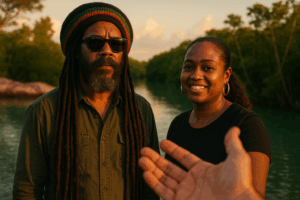As discussions intensify around the prospect of deep-sea mining in the Cook Islands, a once-overlooked geological treasure might chart the nation's economic future. The seabed beneath the Pacific Ocean holds polymetallic nodules, rich in cobalt, nickel, and manganese, minerals now sought after for renewable energy devices including electric vehicles and smartphones.
“I see them as precious resources,” insists Jean Mason, curator of the Cook Islands Library and Museum, as she shows a polymetallic nodule resembling a chocolate truffle. Premier Mark Brown is championing the push to tap these resources, hoping they will revolutionize the economic landscape of these 15 volcanic islands faced with the alarming realities of climate change.
As global sea levels rise, the ocean is both a critical lifeline and an alarming threat to the islands. They rely heavily on fishing and tourism, which comprises over 70% of their GDP, but the allure of potential mineral wealth is increasingly hard to ignore. The Cook Islands' Seabeds Minerals Authority estimates a staggering 12 billion wet tonnes of polymetallic nodules await extraction within their waters. In 2022, exploration licenses were distributed among various companies, prompting a surge of interest in seabed mining.
Proponents argue that harvesting these nodules can help meet the world’s transition to renewable energy while claiming that deep-sea mining is less invasive than traditional mining. However, opponents express deep-seated concern over the environmental consequences of exploring one of the planet's last untouched ecosystems. Activist Alanah Matamaru Smith stresses the need for comprehensive independent studies to better understand the marine impacts, asserting that the rush to monetize the seabed is premature and potentially destructive.
Despite the allure of wealth, some locals remain skeptical. June Hosking, an outspoken activist from Mauke, warns that insufficient consultation is taking place in communities across the islands. People are hesitant to voice concerns during discussions, leading to an uneven representation of opinions among those directly affected by mining ambitions.
Premiers Brown, who wears multiple hats as tourism and seabed minerals minister, draws comparisons to Norway's wealth fund, envisioning a future where local students can gain international education without daunting debt. He believes the mining venture could provide essential healthcare infrastructure and establish sustainable livelihoods, allowing residents to thrive without leaving their homeland.
The debate illustrates a crossroads for the Cook Islands as they contemplate a path that could either secure economic stability or compromise their fragile ecosystem. As voices from both sides of the argument grow louder, the choice facing this Pacific nation is not merely about resources; it is about the lasting legacy they wish to shape for future generations.
“I see them as precious resources,” insists Jean Mason, curator of the Cook Islands Library and Museum, as she shows a polymetallic nodule resembling a chocolate truffle. Premier Mark Brown is championing the push to tap these resources, hoping they will revolutionize the economic landscape of these 15 volcanic islands faced with the alarming realities of climate change.
As global sea levels rise, the ocean is both a critical lifeline and an alarming threat to the islands. They rely heavily on fishing and tourism, which comprises over 70% of their GDP, but the allure of potential mineral wealth is increasingly hard to ignore. The Cook Islands' Seabeds Minerals Authority estimates a staggering 12 billion wet tonnes of polymetallic nodules await extraction within their waters. In 2022, exploration licenses were distributed among various companies, prompting a surge of interest in seabed mining.
Proponents argue that harvesting these nodules can help meet the world’s transition to renewable energy while claiming that deep-sea mining is less invasive than traditional mining. However, opponents express deep-seated concern over the environmental consequences of exploring one of the planet's last untouched ecosystems. Activist Alanah Matamaru Smith stresses the need for comprehensive independent studies to better understand the marine impacts, asserting that the rush to monetize the seabed is premature and potentially destructive.
Despite the allure of wealth, some locals remain skeptical. June Hosking, an outspoken activist from Mauke, warns that insufficient consultation is taking place in communities across the islands. People are hesitant to voice concerns during discussions, leading to an uneven representation of opinions among those directly affected by mining ambitions.
Premiers Brown, who wears multiple hats as tourism and seabed minerals minister, draws comparisons to Norway's wealth fund, envisioning a future where local students can gain international education without daunting debt. He believes the mining venture could provide essential healthcare infrastructure and establish sustainable livelihoods, allowing residents to thrive without leaving their homeland.
The debate illustrates a crossroads for the Cook Islands as they contemplate a path that could either secure economic stability or compromise their fragile ecosystem. As voices from both sides of the argument grow louder, the choice facing this Pacific nation is not merely about resources; it is about the lasting legacy they wish to shape for future generations.






















